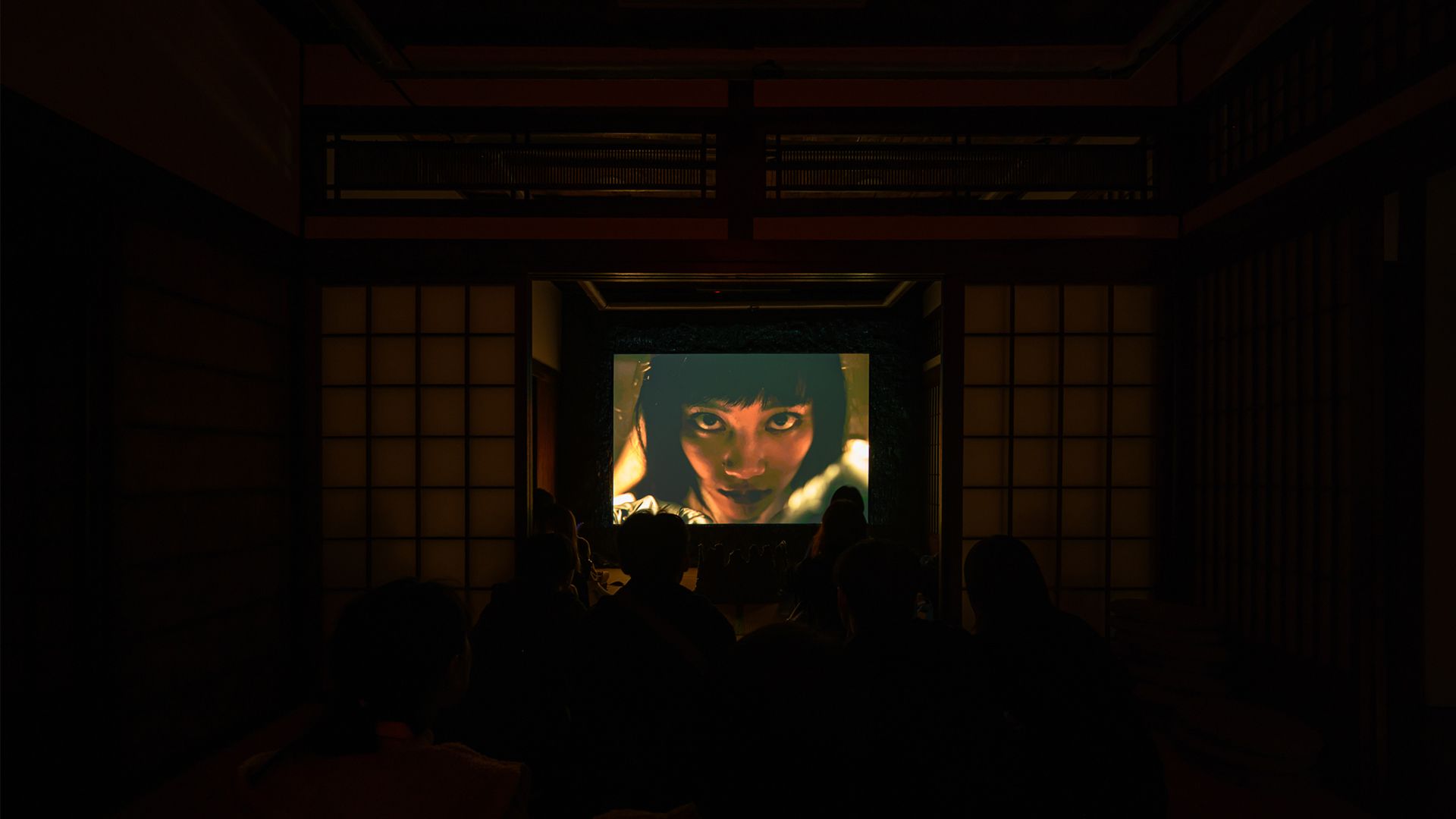
UZU is an interactive film project launched by TTC Studios in collaboration with film director Chia-Hsin Liu and supported by the ‘2022 Future Content’ initiative provided by Taiwan Creative Content Agency (TAICCA) The film stars emerging Taiwanese actress Sushi Tian, actor Huang Shinzhu, and voice actress Liu Chu-Ping. The project itself represents an ambitious undertaking, allowing viewers a unique viewing experience through a combination of mobile gaming, interactive technology, and an overall immersive approach. Instead of following the linear plots typical of most film narratives, each individual participant is given the power to shape the protagonist’s choices, ultimately leading to a diverse range of possible narrative outcomes.
The Story
Though at first it might seem to resemble such a story, UZU’s narrative diverges from the kind of teenage love tale that might unfold in a typical high school setting. After Jie's suicide, his classmate Ai cannot help but relentlessly seek after what it was that might have led to his death. In the midst of the numerous mysteries that Ai uncovers along the way, she also unearths many painful memories the two of them have shared. As this story unfolds, the game UZU, which had always served as Ai's escape from reality, also performs an important role, gradually eroding the boundary between reality and the virtual world.
Interactive Film
During each 40-minute session the audience actively engages by making choices at crucial junctures of the story, steering its development via their smartphones. Through the making of collective decisions alongside fellow attendees, audience members guide the protagonists' actions, ultimately influencing the outcomes of the film’s possible narrative endings.
Immersive Installation
UZU is also a site-specific installation situated inside a traditional Japanese building, adding further contextual layers to both the forms and content of the film. Employing a dynamic multi-channel audio and lighting system, the project achieves a greater sense of perceptive depth by stimulating an array of sensory illusion—the subtle echoes of footsteps, resonating claps of thunder, lingering breaths—to extend the perceptual presence of characters beyond the cinematic realm.
This integration of audio-visual elements transcends the mere simulation of environmental ambiance; it curates an immersive experience. Participants are enveloped within an environment that evokes the sensation of characters meandering through the various corners of the building itself. The dynamic interplay of sound and lighting blur the boundary between the virtual world of the film and the reality in which it is being played.
The Video Game
At the same time, TTC Studios has released a director’s cut version of the video game 'UZU,' in which the protagonists of the film, Ai and Jie, find themselves reimagined as anime characters. Set in 1990s Taipei, players experience the narrative from the viewpoint of Jie, a high school student. The game navigates through diverse scenes, ranging from bustling electronic markets to bookstores vending pirated DVDs and erotic magazines.
The game is divided into three weeks, for a total of twenty days of gameplay. In the first week, the protagonist, Jie, meets a girl named Ai and embarks upon a love story. In the second week, the protagonist's feelings for Ai gradually deepen. However, the game starts to experience various system abnormalities, and at the same time, Ai's self-awareness grows stronger, causing her to rebel against the decisions made by the player. By the third week, Ai begins to harass players, sending increasingly angry messages and causing their phone functions to switch on and off uncontrollably. Players start to feel as though their lives are being taken over by Ai.
In this way, the game UZU attempts to explore the relationship between humans and technology by raising certain questions: are people playing games, or are games playing with people? Are they using the internet, or is the internet using them?
Photo by ANPIS PHOTO
↓ scroll down for video
「渦 UZU」為張碩尹工作室與導演劉家欣合作推出的互動電影計畫,並由文化內容策進院「2022年未來內容製作支持計畫」支持。本片由新銳演員田佳雯(Sushi)與黃信助主演,並邀請劉主平配音,結合手機遊戲、互動科技與沈浸式體驗,在日本老屋(臺灣文學基地(原齊東詩舍))限期映演。參與者將不再以純然線性的方式觀賞電影,而是有權力主導主角的選擇,決定一場充滿曖昧與難以告人謎團的故事之最終結局。
故事
「渦 UZU」為一校園愛情故事。其起始於阿直從頂樓的一躍而下,月愛開始找尋他死亡的蛛絲馬跡。在充滿曖昧與難以告人不堪的謎團之中,月愛挖掘出許多兩人的痛苦回憶。在「渦 UZU」的虛擬戀愛遊戲裡,也有著名叫「月愛」的少女。追尋著漩渦的源頭,同時也被漩渦侵蝕著虛實的界線。這是一個無法登出的遊戲,還是一個無法離開的現實世界⋯⋯
互動影片
在每個40分鐘的場次中,觀眾在故事的關鍵時刻中做出選擇,並透過他們的手機引導故事的發展。透過投票機制,場次中的所有參與者共同做出集體決策,引導主角的行動,最終決定影片的結局。
沉浸式裝置
「渦 UZU」同時也是一個設置在日式老屋的現地製作裝置,其進一步為互動電影增添了更多的閱讀層次。本計畫運用多聲道音頻和燈光系統,創造一系列感官體驗——細微的腳步回聲、共鳴的雷聲、縈繞的呼吸聲——讓影片中的角色超越出電影銀幕,成為在展間中的感知存在。
如此沈浸式的整合不僅是模擬環境氛圍,更營造了特殊沉浸式體驗。參與者身處其中,仿佛能感受到角色漫步於建築各個角落的感覺。聲音和燈光的交織模糊了電影世界與現實之間的界限。
手機遊戲
同時,張碩尹工作室也發行了導演剪輯版的電子遊戲《漩渦》,在這個遊戲中,影片的主角阿直與月愛轉換成為動漫角色。《漩渦》故事背景設定在1990年代的台北,玩家從高中生阿直的視角穿梭於各種場景之間,從熙攘的電子市場、販賣盜版DVD到色情雜誌的書店。
遊戲分為三個星期,總共二十天的遊戲時間。在第一周,主角阿直遇見了一個名叫越愛的女孩並開始了一段愛情故事。在第二周,主角對月愛的感情逐漸加深。這時遊戲開始出現各種系統異常,同時,月愛的自我意識變得更強,使她開始反抗玩家所做的決定。到了第三周,月愛開始騷擾玩家,發送越來越密集的訊息,並造成玩家的手機功能的異常。玩家開始感覺自己的生活開始被月愛所控制。
通過這種方式,《漩渦》遊戲試圖探索人與科技之間的關係,提出一些問題:是人在玩遊戲,還是遊戲在玩弄人?是人在使用網路,還是網路在利用人?
撮影:王世邦
↓ 影片請往下滑
https://drive.google.com/file/d/1BsOyeoHLu9pIXXL5T7_TmVYQRUvteznm/view
https://drive.google.com/file/d/13aiSwMsd7ip-6e80eOS1TJXnnOdNVIK6/view
https://drive.google.com/file/d/1sWsGODTaFvUm6O72788jQAyH1JVAS4-6/view?usp=drive_link
Artistic Team|Artist: Ting-Tong Chang | Director: Chia-Hsin Liu | Executive Producer: Ting-Tong Chang | Script Writer: Kai-Ting Yang, Heidi Ni, Ting-Tong Chang | Script Development: Junu Wu | Cast: Sushi Tian, Ture|Producer: Chun-Han Lin|Production Coordinator: Yili Chen|Production Assistant: Nicole Wang|Production Interns: Candice Tseng, Yoyo Qiu|Director of Photography: Chia-Hsin Liu, Yung-Chih Hsu|Assistant Camera: Tien-Ssu Chen|Production Designer: Yin-Chiao Liao
Assistant Art Director: Ru Chang|Prop Master: Bo-Deng Hu, Yi-Jin Tsai|Costume Designer: Yu-Lin Fan|Makeup Artist: Chih-Hui Wu|Editor: Hsuan-Kang Tsai|Sound Designer and Mixer: Chih-Ming Feng、Chieh-Hsi Chen|Sound Choreographer: Yen-Chun Chen|Voice Actors: Chu-Ping Liu, Song-Yu Chung|Colorist: Che-Chun Liu、Yung-Chih Hsu|Film Camera: Ting-Tong Chang|Behind the Scenes: Yin-Chiao Liao|3D Scanner: Kao-Hsien Lang, Ian Wu
Exhibition Design: Ting-Tong Chang|Technical Coordination: Kao-Hsien Lang|Interactive Design: Jackie Chen|Light & Sound Integration: Kai-Lun Zheng|Lighting Design: Hsien-Yu Cheng|Sound Designer and Mixer: Chih-Ming Feng|Installation Production: Kuo-Wei Lin|NFT Coordinator: Bao-Cheng Zhang|Technical Planning and Execution: L’Atelier Muxuan
Web Development|Front-end Developer: Jonas Chou|Back-end Developer: James Chou|Designer: Avery Chen|Project Manager: Jin Lee|Content Strategist: Lucky Chen|Coordinator: Ray Wang|Marketing: Wen-Xin Song|Media PR Promotion: Elanor Hsinho Wang|Graphic Design: Gina Lee|Ticketing: Yu-Hsin Hung|Staff: Yu-Hsin Hung, Ting-Hsuan Hsu, Cheng-Xsuan Wu|Special Thanks: Wei-Husan Sung, Wade Ding, Jian Cheng Junior High School, Taipei City, Shimen Sesame Grand Hotel Executive Committee, Taiwan Literature Base
This project development was supported by 2022 Future Content of Taiwan Creative Content Agency (TAICCA).
製作團隊|藝術家:張碩尹|導演:劉家欣|監製:張碩尹|編劇:楊凱婷、倪瑞宏、張碩尹|前期劇本開發:吳俊佑|演員:田佳雯、黃信助|製片:林君翰|執行製片:陳怡莉|生活製片:王郁慈|製片組實習生:曾莞涵、邱子柔|攝影指導:劉家欣、徐湧智|攝影助理:陳天賜|美術指導:廖音喬|美術執行:張洳瀞|美術助理:胡博登、蔡沂瑾|造型指導:范玉霖|妝髮造型:吳致憓|剪輯:蔡弦剛|聲音設計:馮志銘、陳婕希|聲音指導:陳彥鈞|聲音演員:劉主平、宋昱璁|調光:劉哲均、徐湧智|底片攝影:張碩尹|側拍:廖音喬|3D掃描:高憲郎、吳宜曄
展場設計:張碩尹|技術統籌:高憲郎|互動程式設計:陳俊儒|燈光聲音系統整合:鄭開倫|燈光設計:鄭先喻|音景設計:馮志銘、陳婕希|裝置設計:林國瑋|NFT協力:張寶成|展場技術:牧晅
網站建置|前端工程師:周嘉銘|後端工程師:周嘉隆|設計師:陳芝竹|專案經理:李秉謙|策略統籌:陳運成|行政統籌:王芮瑀|行銷:宋文心|媒體公關:王欣翮|視覺設計:李激娘|票務:洪瑜馨|現場協力:洪瑜馨、許庭瑄、吳晨瑄|特別感謝:宋微暄、丁肇輝、臺北市立建成國民中學、石門芝蔴大酒店執行委員會、臺灣文學基地
本作品開發獲文化內容策進院「2022年未來內容製作支持計畫」支持